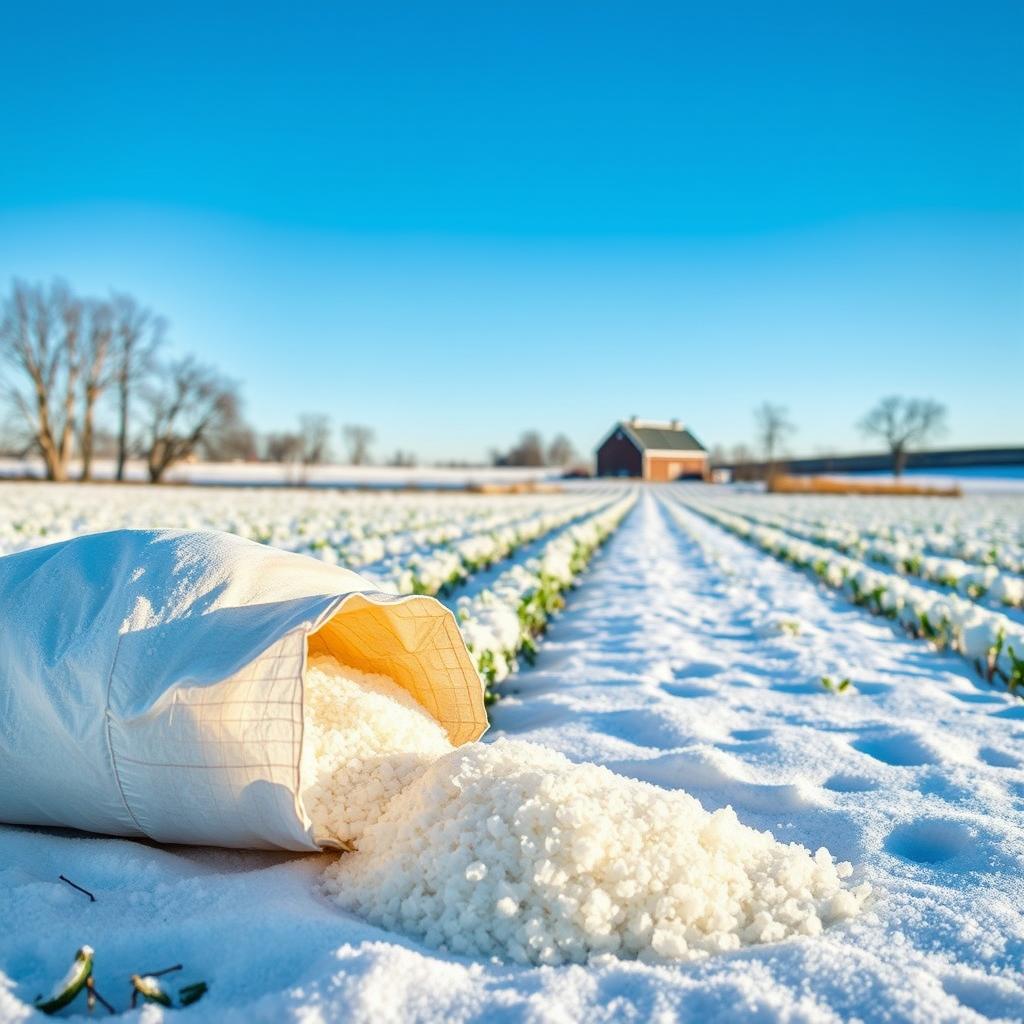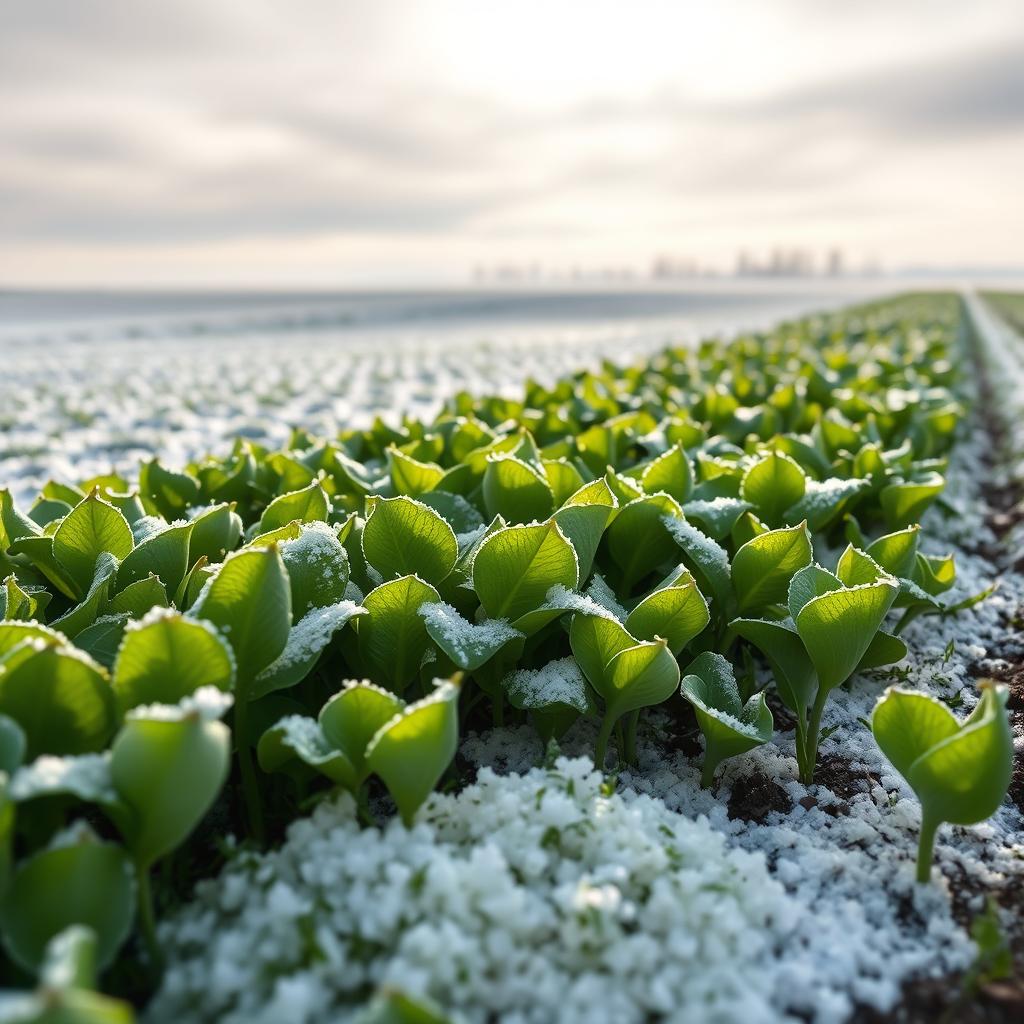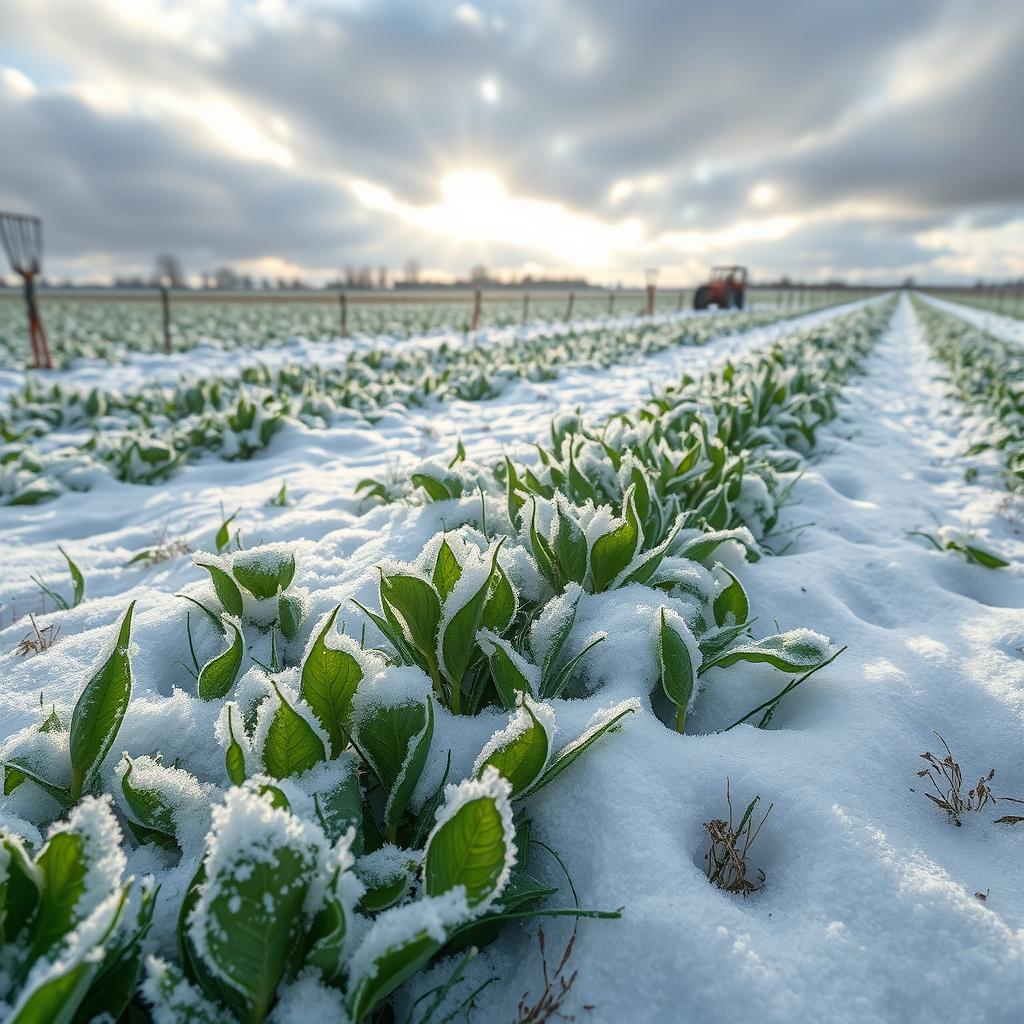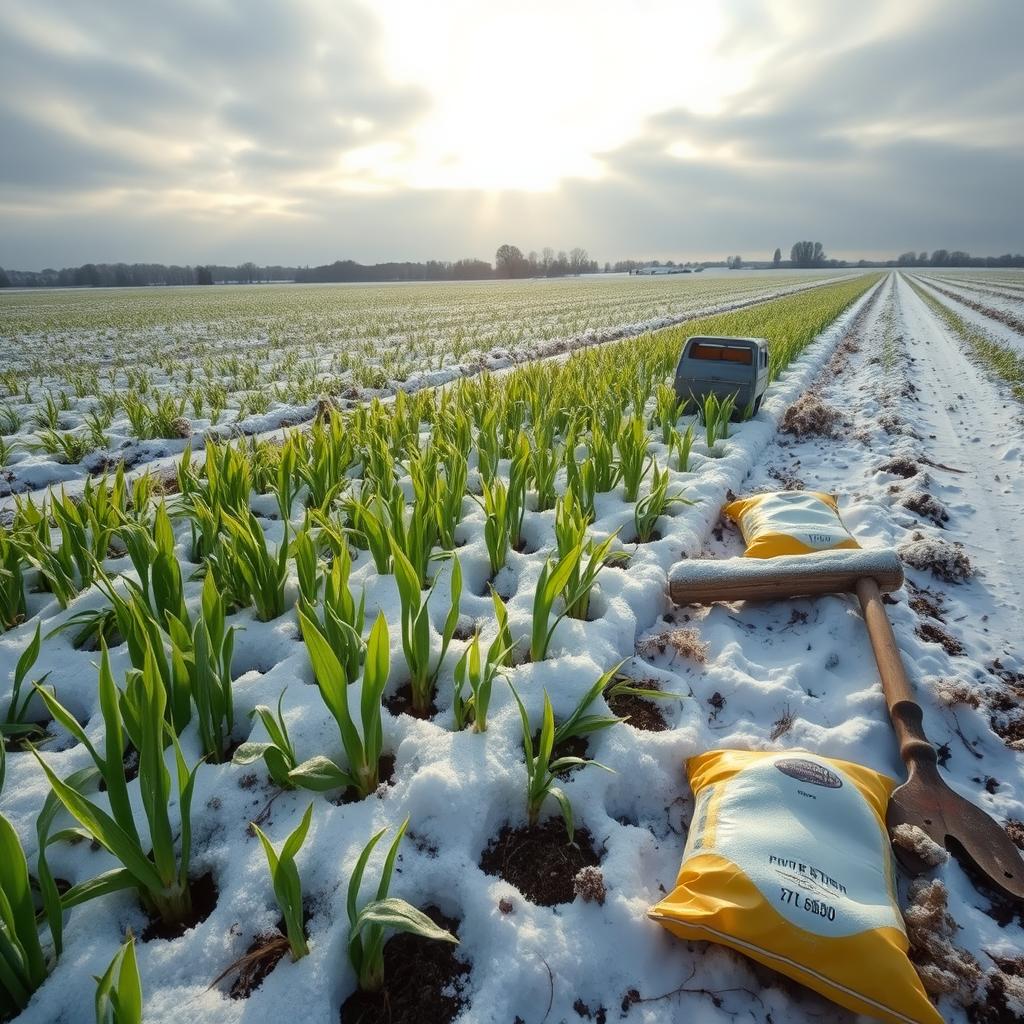What if a simple solution could help winter crops survive better with potassium nitrate? This substance has many benefits for crops. It can be a big help for farmers as the cold weather comes. Many farmers struggle to keep their crops safe from the cold. But, potassium nitrate can make a big difference. It helps crops stay strong and grow well even in the cold.
Click to use Silverigroup personal shopper services
Key Takeaways:
- Potassium nitrate can improve winter crop survival rates
- It enhances crop resilience in cold weather
- Potassium nitrate benefits for crops include improved yield and quality
- Proper application and management are crucial for optimal results
- Winter crop survival with potassium nitrate requires careful planning and execution
Click to buy citric acid from Silvairgroup
Understanding Potassium Nitrate and Its Role in Winter Agriculture
Potassium nitrate is key for better crops in winter. It works well because of its special mix of chemicals. Knowing how it helps winter crops lets farmers use it wisely. Winter crops face tough weather. Cold temperatures and limited sunlight hurt their growth. Potassium nitrate gives them the nutrients they need to grow strong in harsh weather.
Chemical Composition and Properties
Potassium nitrate is a natural compound full of potassium and nitrogen. These nutrients are crucial for plants. Its mix makes it perfect for winter crops, helping them grow well in cold.
The Science Behind Potassium Nitrate’s Effectiveness
Potassium nitrate’s power comes from giving winter crops the nutrients they need. By using it, farmers can boost their crops’ yield in cold weather. This is vital for crops that struggle in the cold and dark.

Key Benefits of Potassium Nitrate for Winter Crops
Using potassium nitrate for winter crops can greatly improve growth and yield. It helps crops survive and thrive in cold weather. This is because it gives them the nutrients they need. Some key benefits of potassium nitrate for winter crops include:
- Improved crop yield and quality
- Enhanced crop resistance to disease and pests
- Increased crop growth rates
- Better crop survival rates during extreme weather conditions
Click to buy Citric Acid Anhydrous from Silvairgroup
Potassium nitrate is a valuable tool for managing winter crops. It helps crops grow stronger and healthier. This leads to a more abundant harvest. A study showed that using potassium nitrate can boost crop yields by up to 20%. It does this by providing vital nutrients during the cold winter months.
In summary, potassium nitrate is a great choice for winter crop management. It gives crops the nutrients they need to grow well. This results in healthier crops and a more bountiful harvest.
| Benefits of Potassium Nitrate | Description |
|---|---|
| Improved crop yield and quality | Potassium nitrate provides essential nutrients to the crops, helping them to grow and thrive during the cold winter months. |
| Enhanced crop resistance to disease and pests | Potassium nitrate helps to strengthen the crops’ immune system, making them more resistant to disease and pests. |
| Increased crop growth rates | Potassium nitrate provides essential nutrients to the crops, helping them to grow faster and stronger. |
Preparing Your Winter Crops for Cold Weather Treatment
As winter comes, farmers must prepare their crops for the cold. Using potassium nitrate in winter farming helps crops grow strong. It fights off diseases and pests by providing key nutrients.
Before using potassium nitrate, farmers should test their soil. This tells them what nutrients are missing. They can then decide how much potassium nitrate to use. They also need to check the soil’s pH and moisture levels for the best results.
Equipment and Tools Needed
Here’s what you need to apply potassium nitrate:
- Soil testing kit
- Spreaders or sprayers
- Measuring cups or scales
- Protective gear, such as gloves and masks
Click to buy liquid Citric Acid from Silvairgroup
Using potassium nitrate in winter farming boosts crop yields and fights off diseases.

Soil Testing and Analysis
Soil testing is key to getting winter crops ready for cold weather. It helps farmers know how much potassium nitrate to use. This ensures the best results and saves resources.
| Soil Test | Recommended Level |
|---|---|
| pH | 6.0-7.0 |
| Nitrogen | 50-100 ppm |
| Phosphorus | 20-50 ppm |
Application Methods and Timing Strategies
Increasing winter crop survival with potassium nitrate depends on how and when you apply it. Farmers can choose from foliar application, soil amendment, and fertigation. Each method has its own benefits and considerations. The right choice depends on the crop type, soil condition, and climate. Foliar application sprays potassium nitrate on plant leaves. It’s quick and efficient for sensitive crops or those with shallow roots. On the other hand, soil amendment mixes potassium nitrate into the soil. It’s best for crops with deep roots needing steady nutrients.
- Foliar application: suitable for crops with limited root development or sensitive to soil-borne diseases
- Soil amendment: ideal for crops with deep root systems and steady nutrient requirements
- Fertigation: a combination of foliar application and soil amendment, providing a balanced nutrient supply
Click to buy frozen a grade beluga fish from Silverigroup
Timing is key when applying potassium nitrate to winter crops. The best time depends on the crop’s growth stage, weather, and soil temperature. Applying it early in growth can help crops develop healthily and survive winter better.
Understanding application methods and timing helps farmers use potassium nitrate effectively. Whether through foliar application, soil amendment, or fertigation, the goal is to give the right nutrients at the right time. This supports healthy growth and development.
| Application Method | Crop Type | Timing |
|---|---|---|
| Foliar Application | Sensitive Crops | Early Growth Stage |
| Soil Amendment | Deep-Rooted Crops | Pre-Planting |
| Fertigation | Balanced Crops | Throughout Growth Stage |
Winter Crop Survival with Potassium Nitrate: Best Practices
Potassium nitrate is key for making crops more resilient in winter. It helps with root growth and fights off diseases. Farmers can apply it in different ways, like spraying it on leaves, mixing it into the soil, or using it in irrigation systems.
Foliar Application Techniques
Foliar application means spraying potassium nitrate on plant leaves. It gives crops a quick nutrient boost. Here are some tips for doing it right:
- Use a spray nozzle for even coverage
- Apply in the early morning or late evening to reduce evaporation
- Check the weather forecast to avoid rain or extreme heat

Soil Amendment Methods
Soil amendment adds potassium nitrate to the soil for a slow release of nutrients. It’s good for long-term crop health. Here’s how to do it well:
- Do soil tests to find the right amount of potassium nitrate
- Use a spreader for even soil coverage
- Work the potassium nitrate into the soil with tillage or irrigation
Monitoring and Adjusting Treatment Levels
To use potassium nitrate for winter crops well, you must watch and tweak the levels. Check the crops’ health and growth often. Adjust the potassium nitrate use as needed. This helps farmers get better yields in cold weather.
When adjusting, think about soil moisture, temperature, and the crop’s stage. Too dry soil means the crop can’t take in the potassium nitrate. Too much moisture can cause nutrient loss. Farmers should consider these to know when and how to apply potassium nitrate. Here are some tips for monitoring and adjusting treatment levels:
- Regularly check soil moisture and temperature to determine the optimal time for application
- Monitor crop growth stage to ensure that potassium nitrate is applied at the most effective time
- Adjust treatment levels based on crop response and weather conditions
By following these tips and using potassium nitrate for winter crops, farmers can boost yields in cold weather. Improving yields in cold weather needs a full plan. This includes good soil, enough nutrients, and pest control. A complete approach to winter farming helps farmers get the most from their crops and succeed in the long run.
| Factor | Optimal Level | Adjustment |
|---|---|---|
| Soil Moisture | 20-30% | Adjust application time based on soil moisture levels |
| Temperature | 40-60°F | Adjust application rate based on temperature |
| Crop Growth Stage | V6-V8 | Adjust application time based on crop growth stage |

Common Challenges and Solutions
Using potassium nitrate to grow crops in winter is key for success. But, farmers face several hurdles. Nutrient deficiencies can hurt crop yields a lot. Knowing how potassium nitrate works in winter farming helps farmers manage stress and fix application problems. Some common challenges with using potassium nitrate in winter farming are:
- Nutrient deficiencies: Potassium nitrate can fix these, but farmers need to watch soil and crop health closely.
- Environmental stress: Winter crops face extreme weather and moisture. Potassium nitrate can help, but farmers must watch out for risks.
- Application issues: Wrong use of potassium nitrate can harm crops. Farmers should apply it correctly to get the best results.
Knowing these challenges and how to solve them helps farmers use potassium nitrate better. This leads to healthier crops and more profit. Understanding challenges and solutions for using potassium nitrate on winter crops helps farmers make smart choices. This knowledge is crucial for successful winter farming. By following best practices, farmers can have a great harvest.
| Challenge | Solution |
|---|---|
| Nutrient deficiencies | Monitor soil and crop health, adjust application rates as needed |
| Environmental stress | Use potassium nitrate to mitigate stress, ensure proper application timing and methods |
| Application issues | Follow best practices for application timing and methods, ensure proper equipment and training |
Maximizing Crop Yield Through Winter
Farmers can boost crop yield in winter by using potassium nitrate. This helps increase the survival rate of winter crops. As a result, crops grow healthier and stronger. This leads to better yields and more productive farming. Some key strategies for maximizing crop yield through winter include:
- Applying potassium nitrate at the right time to enhance crop growth and development
- Monitoring soil conditions to ensure optimal nutrient levels
- Using increasing winter crop survival rate with potassium nitrate as a guide to inform application decisions
By using these strategies and the benefits of potassium nitrate for winter crops, farmers can increase their yields. This makes potassium nitrate a valuable tool for winter farming.

The secret to better winter yields is knowing how potassium nitrate helps crops grow. By applying this knowledge, farmers can boost their productivity and success.
| Strategy | Benefits |
|---|---|
| Applying potassium nitrate at the right time | Enhanced crop growth and development |
| Monitoring soil conditions | Optimal nutrient levels |
| Using increasing winter crop survival rate with potassium nitrate as a guide | Informed application decisions |
Conclusion: Ensuring Long-term Winter Crop Success
Winter crop survival with potassium nitrate is key for healthy fields in cold months. Knowing the benefits of potassium nitrate for crops helps farmers. This way, their winter crops can not only survive but also grow well, even in tough weather.
Soil testing, getting ready before applying, and using the right methods are important. This article helps growers tackle nutrient gaps, handle environmental stress, and fix any problems. By using potassium nitrate wisely, farmers can expect strong, high-yielding winter crops. This leads to a successful harvest over the long term. With the right approach and care, growing crops through winter becomes easier. This opens the door to a fruitful growing season.
FAQ: Winter Crop Survival with Potassium Nitrate
How can potassium nitrate help improve winter crop survival?
Potassium nitrate is a valuable tool for winter crops. It helps plants handle cold temperatures and frost better. This leads to higher survival rates and yields.
What are the key benefits of using potassium nitrate for winter crops?
Using potassium nitrate offers several benefits. It improves cold tolerance and nutrient uptake. It also boosts root development and plant vigor. It helps protect against drought and frost, too.
How does the chemical composition of potassium nitrate make it effective for winter crop management?
Potassium nitrate is special because it has potassium and nitrogen. Potassium strengthens cell walls and improves cold hardiness. Nitrogen promotes healthy foliage. This makes it great for winter crops.
What are the best practices for applying potassium nitrate to winter crops?
Applying potassium nitrate correctly is crucial. Start with soil testing to find the right amount. Apply it at the right time and use the best method for your crop and soil.
How can farmers monitor and adjust potassium nitrate treatment levels for their winter crops?
Farmers need to watch their crops closely and adjust as needed. Check plant health, nutrient levels, and the environment. Adjust the application rate or timing to keep crops performing well.
What are some common challenges when using potassium nitrate for winter crop management, and how can they be addressed?
Challenges include nutrient deficiencies and environmental stresses. To solve these, test your soil, adjust application rates, and use the right equipment. This will help your crops thrive.
How can farmers maximize their winter crop yields by using potassium nitrate?
By using potassium nitrate, farmers can boost yields. It improves cold tolerance and nutrient uptake. Follow best practices and address challenges to get the most out of it.

